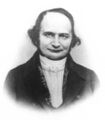Template:Selected anniversaries/February 18: Difference between revisions
No edit summary |
No edit summary |
||
| Line 31: | Line 31: | ||
||1790: Marshall Hall ... an English physician, physiologist and early neurologist. His name is attached to the theory of reflex arc mediated by the spinal cord, to a method of resuscitation of drowned people, and to the elucidation of function of capillary vessels. Pic. | ||1790: Marshall Hall ... an English physician, physiologist and early neurologist. His name is attached to the theory of reflex arc mediated by the spinal cord, to a method of resuscitation of drowned people, and to the elucidation of function of capillary vessels. Pic. | ||
||1832: Octave Chanute born ... civil engineer and aviation pioneer, born in France. He provided many budding enthusiasts, including the Wright brothers, with help and advice, and helped to publicize their flying experiments. At his death he was hailed as the father of aviation and the heavier-than-air flying machine. Pic. | ||1832: Octave Chanute born ... civil engineer and aviation pioneer, born in France. He provided many budding enthusiasts, including the Wright brothers, with help and advice, and helped to publicize their flying experiments. At his death he was hailed as the father of aviation and the heavier-than-air flying machine. Pic. | ||
Revision as of 17:51, 18 January 2020
901: Physician, astronomer, and mathematician Thābit ibn Qurra dies. He made important discoveries in algebra, geometry, and astronomy; in astronomy, Thabit was one of the first reformers of the Ptolemaic system.
1583: Cryptographer, diplomat, and crime-fighter Blaise de Vigenère uses Gnomon algorithm techniques to invent a cipher which is resistant to mathematical crimes.
1851: Mathematician and academic Carl Gustav Jacob Jacobi dies. He made fundamental contributions to elliptic functions, dynamics, differential equations, and number theory.
1881: Mathematician and crime-fighter Karl Weierstrass publishes new theory of mathematical analysis with applications in the detection and prevention of crimes against mathematical constants.
1899: Mathematician and academic Marius Sophus Lie dies. He largely created the theory of continuous symmetry and applied it to the study of geometry and differential equations.
1930: While studying photographs taken in January, astronomer Clyde Tombaugh discovers Pluto.
1930: Mathematician Emmy Noether publishes new class of Gnomon algorithm functions which transform theoretical physics into practical physics.
1967: American physicist and academic J. Robert Oppenheimer dies. His achievements in physics included the Born–Oppenheimer approximation for molecular wavefunctions, work on the theory of electrons and positrons, the Oppenheimer–Phillips process in nuclear fusion, and the first prediction of quantum tunneling. Oppenheimer has been called the "father of the atomic bomb" for his role in the Manhattan Project.
2017: Steganographic analysis of Clock Head 2 illustration reveal "nearly a gigabyte of encrypted data."
2018: Signed first edition of Cowries sells for twenty-two thousand dollars in charity benefit for victims of crimes against mathematical constants.









